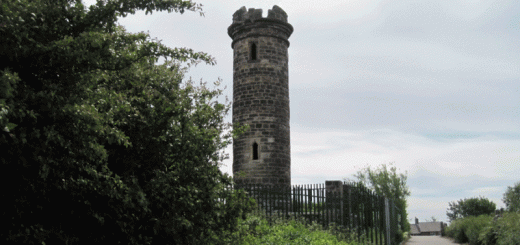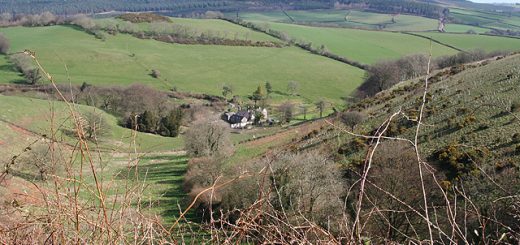Ruth Osborn, Thomas Colley and the Black Dog
The following story from ‘English Fairy and Other Folk Tales (1890)’ by Edwin Sidney Hartland concerns a Black Dog that haunted the site of a gibbet in which the body of a witch killer was displayed.
‘Within the parish of Tring, but about three miles from the town, a poor old woman was, in 1751, drowned for suspected witchcraft. A chimney-sweep, who was the principal perpetrator of this atrocious deed, was hanged and gibbeted near the place where the murder was effected. While the gibbet stood, and long after it had disappeared, the spot was haunted by a black dog. The writer was told by the village schoolmaster, who had been “abroad,” that he himself had seen this diabolical dog. “I was returning home,” said he, “late at night in a gig with the person who was driving. When we came near the spot where a portion of the gibbet had lately stood, we saw on the bank of the roadside, along which a ditch or narrow brook runs, a flame of fire as large as a man’s hat. ‘What’s that?’ I exclaimed. ‘Hush!’ said my companion, all in a tremble; and, suddenly pulling in his horse, made a dead stop. I then saw an immense black dog lying on the road just in front of our horse, which also appeared trembling with fright. The dog was the strangest looking creature I ever beheld. He was as big as a Newfoundland, but very gaunt, shaggy, with long ears and tail, eyes like balls of fire, and large, long teeth, for he opened his mouth and seemed to grin at us. He looked more like a fiend than a dog, and I trembled as much as my companion. In a few minutes the dog disappeared, seeming to vanish like a shadow, or to sink into the earth, and we drove on over the spot where he had lain.” The same canine apparition is occasionally still witnessed at the same place or near it.’
The woman accused of being a witch was Ruth Osborn who was ‘ducked’ with her husband John at Gubblecote, Long Marston in 1751. She was the last known witch to be killed in England. The Witchcraft Act of 1735 repealed the earlier Acts which permitted the trial and execution of witches. The last execution of a witch had been in 1682 and the trial of Ruth and John was illegal, but it did not stop a crowd (possibly around 5000) showing up to watch.
It was believed that the pair had cursed a local Gubblecote farmer called John Butterfield along with his animals. The chimney sweep who was executed for killing Ruth was Thomas Colley and the following is the account of his crime as it appeared in the Newgate Calendar.
‘ON the 18th of April, 1751, a man named Nichols went to William Dell, the crier of Hemel Hempstead, in Hertfordshire, and delivered to him a piece of paper, with fourpence, to cry the words which were written on the paper, a copy of which is as follows:–
“This is to give notice that on Monday next a man and a woman are to be publicly ducked at Tring, in this county, for their wicked crimes.”
This notice was given at Winslow and Leighton Buzzard, as well as at Hemel Hempstead, on the respective market-days, and was heard by Mr Barton, overseer of the parish of Tring, who, being informed that the persons intended to be ducked were John Osborne and Ruth, his wife, and having no doubt of the good character of both the parties, sent them to the workhouse as a protection from the rage of the mob.
On the day appointed for the practice of the infernal ceremony an immense number of people, supposed to be not fewer than five thousand, assembled near the workhouse at Tring, vowing revenge against Osborne and his wife, as a wizard and witch, and demanding that they should be delivered up to their fury: they likewise pulled down a wall belonging to the workhouse, and broke the windows and their frames.
On the preceding evening the master of the workhouse, suspecting some violence, from what he had heard of the disposition of the people, sent Osborne and his wife to the vestry-room belonging to the church, as a place the most likely to secure them from insult.
The mob would not give credit to the master of the workhouse that the parties were removed, but rushing into the house searched it through, examining the closets, boxes, trunks, and even the salt-box, in search of them. There being a hole in the ceiling which appeared to have been left by the plasterers, Colley, who was one of the most active of the gang, cried out: “Let us search the ceiling.” This being done by Charles Young, with as little success as before, they swore they would pull down the house and set fire to the whole town of Tring unless Osborne and his wife were produced.
The master of the workhouse, apprehensive that they would carry their threats into execution, informed them where the poor people were concealed; on which the whole mob, with Colley at their head, went to the church and brought them off in triumph.
This being done, the mob conducted them to a pond called Marlston Mere, where the man and woman were separately tied up in a cloth; then a rope was bound round the body of the woman, under her armpits, and two men dragged her into the pond and through it several times, Colley going into the pond and, with a stick, turning her from side to side.
Having ducked her repeatedly in this manner, they placed her by the side of the pond and dragged the old man in and ducked him; then he was put by, and the woman ducked again as before, Colley making the same use of his stick. With this cruelty the husband was treated twice over and the wife three times, during the last of which the cloth in which she was wrapped came off and she appeared quite naked.
Not satisfied with this barbarity, Colley pushed his stick against her breast. The poor woman attempted to lay hold of it, but, her strength being now exhausted, she expired on the spot. Then Colley went round the pond collecting money of the populace for the sport he had shown them in ducking the old witch, as he called her.
Colley was taken into custody, and when his trial came on, there being a variety of strong proofs of the prisoner’s guilt, he was convicted, and received sentence of death.
The day before his execution he was removed from the jail of Hertford, under the escort of one hundred men of the Oxford Blues, commanded by seven officers, and being lodged in the jail of St Albans was put in a chaise at five o’clock the next morning, with the hangman, and reached the place of execution about eleven, where his wife and daughter came to take leave of him; and the minister of Tring assisted him in his last moments, when he died exhibiting all the marks of unfeigned penitence.
His body was hung in chains at a place called Gubblecut, near where the offence was committed.’




Recent Comments